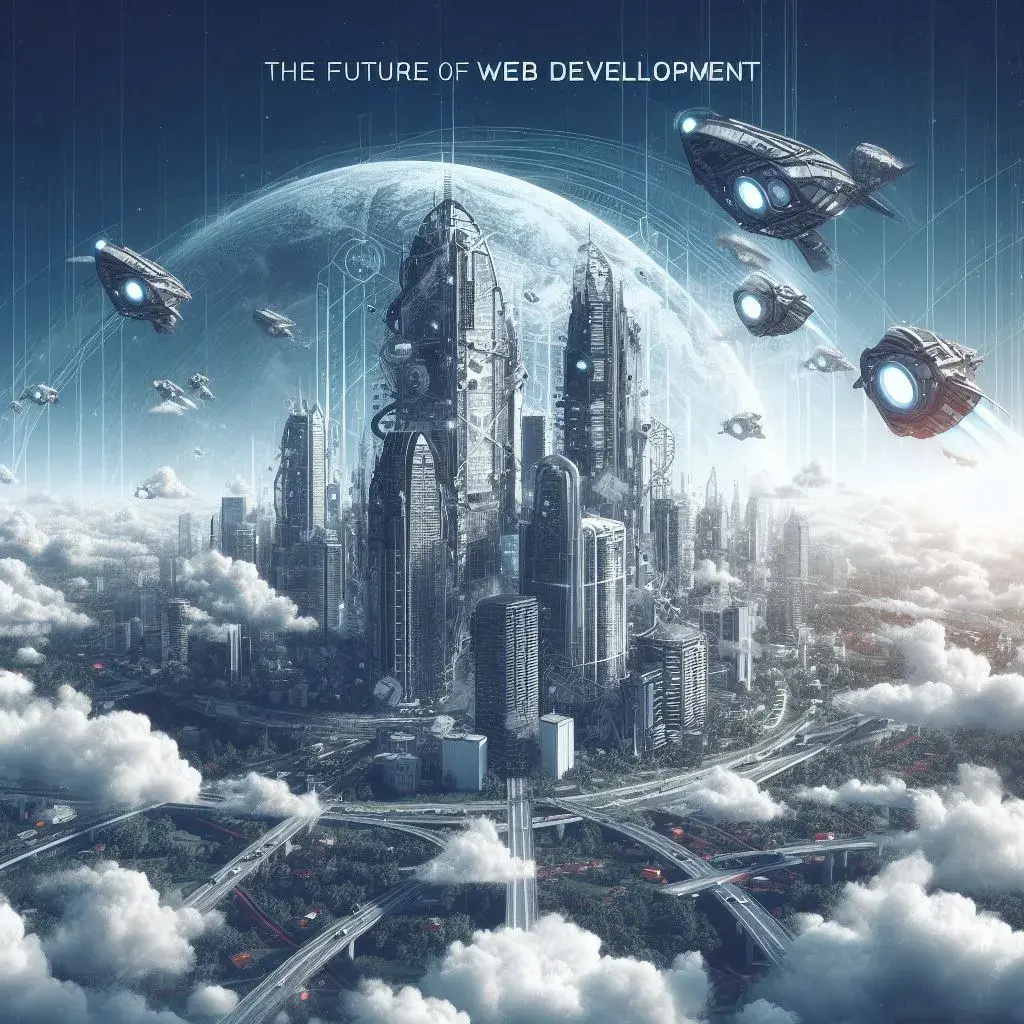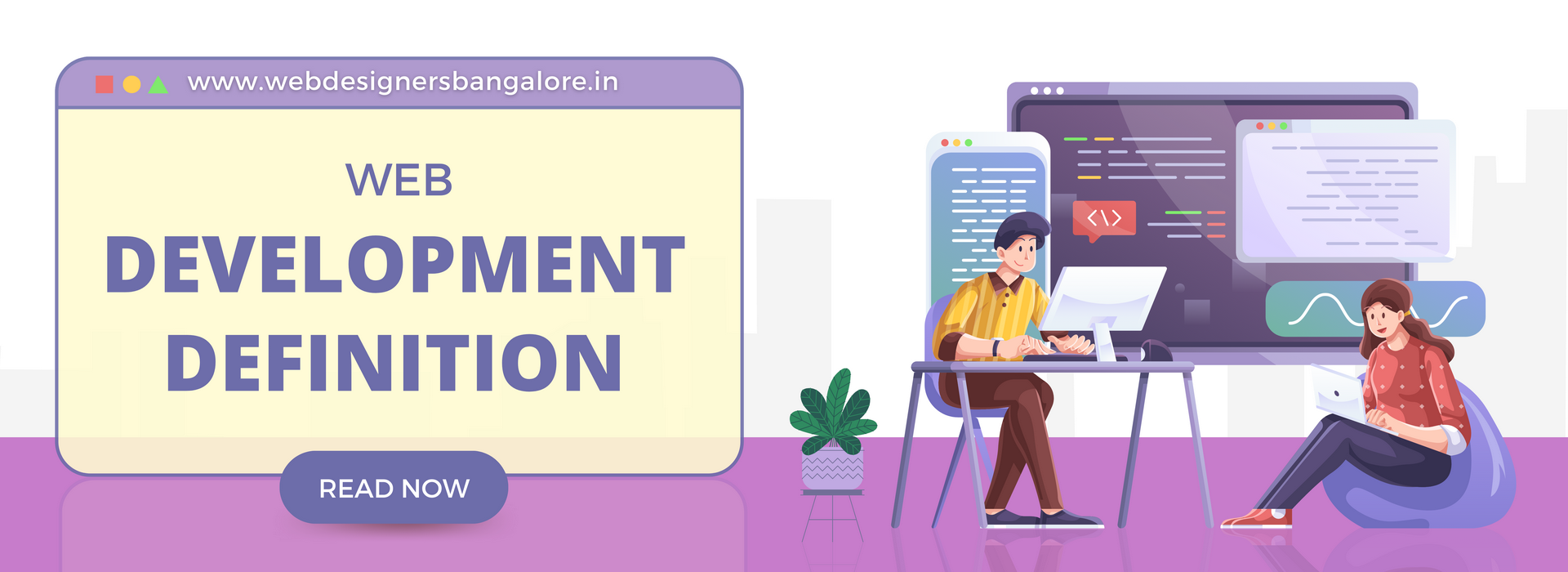In today’s fast-paced digital world, web development plays a crucial role in shaping our online experiences so we decided to explain web development definition and it’s types. Websites have evolved into sophisticated platforms that cater to various needs, from e-commerce to social networking, information dissemination, and much more.
Web development encompasses a broad spectrum of skills and tools, making it a fascinating field for tech enthusiasts and a vital industry for businesses looking to establish a strong online presence. In this comprehensive guide, we will demystify web development by providing a clear definition, exploring its importance, detailing the required skills, discussing different types of web development, and delving into the essential tools. Whether you’re a beginner or a seasoned pro, this article will help you navigate the intricate world of web development.
What is Web Development?

Definition of Web Development
Web development, in its essence, is the process of building and maintaining websites or web applications. It involves a combination of various disciplines, such as coding, design, and project management, aimed at creating a functional and visually appealing digital presence on the internet.
The field of web development is vast, encompassing everything from basic static web pages to complex dynamic web applications. These applications can offer services, collect data, and engage users in various ways. Web developers use a wide array of languages, frameworks, tools, and methodologies to bring these digital entities to life.
Importance of Web Development in Today’s World
The importance of web development in today’s world cannot be overstated. It has become a cornerstone of modern business and communication. Here are some key reasons why web development is vital:
- Global Reach: Websites and web applications have the potential to reach a global audience. This allows businesses to expand their market reach and individuals to share their ideas, content, and services with people worldwide.
- 24/7 Availability: Unlike physical stores or offices, websites are accessible 24/7. This constant availability can significantly improve customer engagement and service.
- Cost-Effective: Web development can be a cost-effective way to establish an online presence. It eliminates many of the expenses associated with traditional brick-and-mortar businesses.
- Data Collection: Web applications can collect valuable data on user behavior, preferences, and interactions, enabling businesses to make informed decisions and provide personalized experiences.
- E-commerce: The rise of e-commerce has transformed the way we shop. Web development is the backbone of online retail, allowing businesses to sell products and services efficiently.
- Information Dissemination: Web development is instrumental in disseminating information, whether it’s news, educational content, or research. It provides a platform for sharing knowledge and connecting people.
- Interaction and Engagement: Web applications provide a platform for interactive content, social networking, and online communities. These platforms facilitate communication and collaboration.
- Search Engine Visibility: Proper web development practices can improve a website’s search engine visibility, leading to more organic traffic.
- User Experience (UX) Design: Creating a user-friendly and visually appealing website or application can enhance the user’s experience, leading to increased engagement and retention.
Required Skills for Web Development

Becoming a web developer is a rewarding journey, but it requires a diverse set of skills. These skills can be broadly categorized into technical and soft skills.
Technical Skills Needed for Web Development
- Programming Languages: A strong understanding of programming languages is fundamental to web development. Some essential languages include HTML, CSS, JavaScript, and more advanced languages like Python, Ruby, and PHP.
- Web Development Frameworks: Frameworks, such as React, Angular, and Django, can streamline development by providing pre-built components and patterns.
- Database Management: Proficiency in database management is essential for creating dynamic web applications. Common database systems include MySQL, PostgreSQL, and MongoDB.
- Server Management: Knowledge of server-side technologies like Apache, Nginx, and Node.js is necessary to deploy and maintain web applications.
- API Integration: Many web applications rely on external data sources. Understanding how to integrate with APIs (Application Programming Interfaces) is crucial.
- Version Control Systems: Proficiency in using version control systems like Git for collaborative development and tracking changes.
- Responsive Web Design: The ability to create websites that are responsive and adapt to different screen sizes and devices is a critical skill.
- Security: Understanding web security best practices to protect against common threats, such as cross-site scripting (XSS) and SQL injection.
- Performance Optimization: Skills in optimizing website performance, including page load times and resource management.
- Testing and Debugging: Proficiency in using testing frameworks and debugging tools to ensure the quality and reliability of web applications.
Soft Skills Needed for Web Development
- Problem-Solving: Web development often involves troubleshooting and finding solutions to technical challenges.
- Creativity: Designing visually appealing and user-friendly interfaces requires creative thinking.
- Communication: Effective communication is essential when collaborating with team members and clients.
- Time Management: Web developers often work on multiple projects with tight deadlines, so time management is crucial.
- Adaptability: The web development landscape evolves rapidly, and developers need to stay up to date with new technologies and best practices.
- Attention to Detail: Small mistakes in code or design can lead to significant issues. Attention to detail is vital.
- Teamwork: Many web development projects are collaborative efforts, so being a team player is important.
- Client-Focused: Understanding the client’s needs and delivering solutions that meet those needs is a key skill for client-based projects.
Importance of Continuous Learning and Improvement
The world of web development is in a constant state of flux. New technologies, languages, frameworks, and best practices emerge regularly. Therefore, a web developer’s journey is an ongoing one. Continuous learning and improvement are critical to staying relevant and advancing in this field. Consider the following strategies for growth:
- Online Courses: There are numerous online platforms, such as Coursera, Udemy, and edX, that offer web development courses and tutorials.
- Community Involvement: Join web development communities and forums, like Stack Overflow or GitHub, to learn from others and share your knowledge.
- Coding Challenges: Participate in coding challenges and hackathons to test your skills and solve real-world problems.
- Networking: Attend web development conferences and meetups to connect with fellow developers and stay informed about industry trends.
- Personal Projects: Work on personal web development projects to apply what you’ve learned and build a portfolio.
- Books and Blogs: Read web development books and follow industry blogs to gain insights and knowledge from experts.
- Mentorship: Seek out experienced web developers who can provide mentorship and guidance in your journey.
Types of Web Development

Web development can be categorized into several specialized areas, each with its unique focus and requirements. Here are the main types of web development:
Frontend Development
Frontend development, also known as client-side development, focuses on creating the visible part of a website or web application that users interact with directly. This involves designing the user interface and implementing the user experience. Frontend developers need to be proficient in a variety of technologies to create engaging and responsive web interfaces.
Languages and Technologies Used in Frontend Development
- HTML (Hypertext Markup Language): HTML is the foundation of web content. It defines the structure of web pages, including headings, paragraphs, links, and images.
- CSS (Cascading Style Sheets): CSS is used for styling web pages. It controls the layout, colors, fonts, and overall visual presentation.
- JavaScript: JavaScript is a versatile programming language that adds interactivity and dynamic behavior to web pages.
- Front-End Frameworks: Frameworks like React, Angular, and Vue.js streamline frontend development by providing ready-made components and data-binding features.
Examples of Frontend Development Projects
- E-commerce Website: Building a user-friendly interface for an online store with product listings, shopping carts, and secure payment processing.
- Social Media Platform: Creating the frontend for a social networking site with user profiles, timelines, and interactive posts.
- News Website: Designing a news portal with responsive layouts for articles, images, and videos.
Backend Development
Backend development, also known as server-side development, focuses on the behind-the-scenes logic and data processing of a website or web application. It involves managing databases, handling server requests, and ensuring that the application functions correctly. Backend developers work with server technologies and databases to create the server-side functionality that powers web applications.
Languages and Technologies Used in Backend Development
- Server-Side Languages: Common backend languages include Python, Ruby, PHP, Java, and Node.js.
- Databases: Backend developers work with relational databases like MySQL and PostgreSQL, as well as NoSQL databases like MongoDB.
- Server Technologies: Technologies like Apache, Nginx, and Express.js are used for handling server requests.
- API Development: Creating APIs that allow communication between the frontend and backend components of an application.
Examples of Backend Development Projects
- Content Management System (CMS): Building a backend system that allows users to create, edit, and manage content on a website.
- E-commerce Platform: Developing the backend of an online store, including inventory management, order processing, user authentication, and payment processing.
- Database-Driven Web Application: Creating a web application that stores and retrieves data from a database, such as a project management tool or a customer relationship management (CRM) system.
Full-Stack Development
Full-stack development involves both front-end and back-end development. The Full-stack developers are proficient in a wide range of technologies and can work on all aspects of a web application. They bridge the gap between the user interface and server-side logic, making them versatile professionals.
Skills Required for Full-Stack Development
- Proficiency in frontend and backend technologies, languages, and frameworks.
- Understanding of the complete web development process, from design to deployment.
- Knowledge of server management, database administration, and API integration.
Examples of Full-Stack Development Projects
- Online Marketplace: Building an end-to-end e-commerce platform that includes the frontend for users to browse products and the backend for managing product listings, orders, and payments.
- Content Sharing Platform: Developing a content-sharing platform that allows users to create, upload, and share content, while also managing user profiles and data.
- Project Management Tool: Creating a project management application with features for task management, user collaboration, and reporting.
- Blogging Platform: Building a blogging platform that includes the frontend for creating and viewing blog posts, as well as the backend for managing user accounts and blog content.
Mobile Development
Mobile development involves creating applications for mobile devices, such as smartphones and tablets. These applications can be native, built specifically for a particular platform (e.g., Android or iOS), or cross-platform, compatible with multiple platforms.
Languages and Technologies Used in Mobile Development
- iOS Development: Swift and Objective-C are the primary languages for iOS app development, and Xcode is the integrated development environment (IDE) of choice.
- Android Development: Java and Kotlin are commonly used for Android app development, with Android Studio as the preferred IDE.
- Cross-Platform Development: Tools like React Native, Flutter, and Xamarin allow developers to create apps that work on both iOS and Android.
Examples of Mobile Development Projects
- Social Media App: Building a mobile application for social networking with features like user profiles, messaging, and photo sharing.
- E-commerce Mobile App: Developing a mobile shopping app with a catalog of products, shopping cart, and secure payment processing.
- Fitness Tracking App: Creating an app that monitors and records user fitness and health data, such as exercise routines, calorie tracking, and health statistics.
Emerging Trends and Technologies in Web Development

The world of web development is continually evolving, with new trends and technologies reshaping the industry. Web developers should stay aware of these emerging trends to remain competitive and create cutting-edge projects. Here are some key trends in web development:
1. Progressive Web Apps (PWAs)
Progressive Web Apps combine the best of web and mobile applications. They offer a seamless user experience, work offline, and can be installed on a user’s device like a native app. Popular frameworks for building PWAs include Vue.js, React, Angular, and tools like the Ionic framework.
2. Serverless Architecture
Serverless computing allows developers to build and run applications without managing servers. Services like AWS Lambda and Azure Functions enable developers to focus on writing code while the cloud provider manages the infrastructure.
3. WebAssembly (Wasm)
WebAssembly is a binary instruction format that enables high-performance execution of code in web browsers. It allows developers to write code in languages like C, C++, and Rust, which can run at near-native speed in the browser.
4. Single Page Applications (SPAs)
Single Page Applications load a single HTML page and dynamically update content as the user interacts with the app. Popular JavaScript frameworks for SPAs include React, Angular, and Vue.js.
5. Motion UI
Motion user interface (UI) design focuses on creating engaging and interactive web experiences through animations and transitions. Libraries like Animate.css and GreenSock Animation Platform (GSAP) are used to implement motion UI.
6. Voice Search and Voice User Interfaces
The rise of voice-activated devices like smart speakers and voice assistants has led to the development of voice search and voice user interfaces for web applications.
7. Artificial Intelligence (AI) and Machine Learning
AI and machine learning are being used to enhance user experiences through personalized content, recommendation systems, and chatbots.
8. Cybersecurity
With the increasing number of cyber threats, web developers need to focus on building secure web applications. This includes using HTTPS, data encryption, and security best practices.
Web Development Career Paths

A career in web development offers diverse paths, each with its own set of responsibilities and requirements. Here are some common web development career paths:
1. Frontend Developer
Frontend developers specialize in creating user interfaces and ensuring the visual and interactive elements of a website or web application are user-friendly. They work with HTML, CSS, and JavaScript and often use frontend frameworks like React, Angular, or Vue.js. Frontend developers should have strong design and user experience (UX) skills.
Typical Education and Experience: A bachelor’s degree in computer science or a related field can be beneficial, but many frontend developers are self-taught. Experience with frontend technologies and a strong portfolio are essential.
2. Backend Developer
Backend developers focus on the server-side logic and data processing of web applications. They work with server technologies, databases, and server-side programming languages. Popular languages for backend development include Python, Ruby, and Node.js. Backend developers are responsible for creating APIs and ensuring the functionality of web applications.
Typical Education and Experience: A bachelor’s degree in computer science or a related field is common, but experience and knowledge of backend technologies are paramount.
3. Full-Stack Developer
Full-stack developers have a broad skill set that encompasses both frontend and backend development. They are capable of building an entire web application, from designing the user interface to managing the server and database. Full-stack developers are highly versatile and can work on various aspects of a project.
Typical Education and Experience: A bachelor’s degree in computer science or a related field is beneficial, but experience in both frontend and backend technologies is essential. A strong portfolio that showcases full-stack projects is valuable.
4. Mobile Developer
Mobile developers specialize in creating applications for mobile devices. They can focus on iOS development, Android development, or cross-platform development. Mobile developers work with languages like Swift, Kotlin, Java, or JavaScript. Their responsibilities include designing mobile interfaces, integrating with device features, and optimizing performance.
Typical Education and Experience: A bachelor’s degree in computer science or a related field can be advantageous. Proficiency in mobile development languages and experience in app development are crucial.
5. DevOps Engineer
DevOps engineers bridge the gap between development and operations. They are responsible for automating and streamlining the development and deployment process. DevOps engineers work with tools like Docker, Kubernetes, and continuous integration/continuous deployment (CI/CD) pipelines to ensure efficient and reliable software delivery.
Typical Education and Experience: A bachelor’s degree in computer science or a related field is common. DevOps engineers should have expertise in development, system administration, and deployment technologies.
6. Security Engineer
Security engineers focus on protecting web applications from vulnerabilities and cyber threats. They perform security audits, implement security measures, and ensure that web applications are safeguarded against attacks. Security engineers work with encryption, penetration testing, and security best practices.
Typical Education and Experience: A bachelor’s degree in computer science, cybersecurity, or a related field is common. Security engineers should have expertise in web security and stay up to date with the latest security threats and solutions.
7. UX/UI Designer
UX/UI designers are responsible for creating user-friendly and visually appealing interfaces. While not strictly developers, they collaborate closely with development teams to ensure a seamless user experience. UX/UI designers work with design tools, wireframes, and user testing to create compelling web interfaces.
Typical Education and Experience: A bachelor’s degree in graphic design, web design, or a related field is common. UX/UI designers should have a strong portfolio showcasing their design skills.
Web Development Resources

To further your journey in web development, here are some resources that you can explore:
- Online Courses and Tutorials:
- Development Communities and Forums:
- Coding Challenges and Hackathons:
- Web Development Conferences and Meetups:
- Check local and virtual events in your area.
- Books and Blogs:
- Mentorship Opportunities:
- Seek out experienced developers in your network or through online communities.
- Advanced Courses and Specializations:
- The Odin Project offers a full-stack web development curriculum.
- freeCodeCamp provides free self-paced coding challenges and full-stack development certifications.
Remember, your journey in web development is unique, and these resources are here to guide and support you as you continue to learn, create, and innovate in this ever-evolving field. Happy coding!
The Future of Web Development

The field of web development is dynamic and constantly evolving. To stay competitive and deliver cutting-edge solutions, web developers must keep an eye on emerging trends and technologies. Let’s explore some of the future directions of web development:
1. Artificial Intelligence (AI) Integration
AI and machine learning are becoming increasingly integral to web development. From chatbots that provide instant customer support to personalized content recommendations, AI is enhancing user experiences.
2. Web 3.0 and Decentralization
Web 3.0 is an evolving concept that emphasizes decentralization, blockchain technology, and user control of data. The web developers will need to adapt to this new paradigm of a user-centric and decentralized web.
3. Augmented Reality (AR) and Virtual Reality (VR)
With the advancement of AR and VR technologies, web developers will find new opportunities in creating immersive web experiences and applications.
4. Enhanced Security Practices
As cyber threats continue to evolve, web developers will need to prioritize security practices, including encryption, multi-factor authentication, and vulnerability assessments.
5. Voice and Conversational Interfaces
Voice search and conversational interfaces are on the rise. Web developers will need to adapt websites and applications to be accessible through voice commands and conversational interactions.
6. Web Performance Optimization
With the increasing importance of mobile devices, web developers will focus on optimizing performance for various screen sizes and connection speeds.
7. Quantum Computing
While still in its early stages, quantum computing holds the potential to revolutionize web development by solving complex problems at unprecedented speeds.
8. Progressive Web Apps (PWAs)
PWAs will continue to gain popularity, offering users app-like experiences on the web while providing web developers with a flexible and efficient development approach.
FAQ about Web Development Definition And Types
Web development is important for a number of reasons. First, it allows businesses to reach a global audience. Second, it can help businesses to increase their sales and improve their customer service. Third, it can help businesses to reduce costs.
Le développement web est le processus de création et de maintenance de sites web et d’applications web. Il englobe un large éventail de compétences et de technologies, notamment la conception web, la programmation web et la gestion de bases de données. Les développeurs web utilisent leurs compétences pour créer des sites web à la fois visuellement attrayants et fonctionnels.
The terms web development and website development are often used interchangeably, but there is a subtle difference between the two. Web development is a broader term that encompasses all aspects of creating and maintaining websites and web applications. Website development is a subset of web development that focuses specifically on the creation and maintenance of websites.
Web development is important for businesses because it allows them to reach a global audience and increase their sales. It can also help businesses to improve their customer service and reduce costs.
Conclusion
Web development is a multifaceted field that empowers businesses, organizations, and individuals to establish their digital presence and provide innovative online experiences. This guide has provided a comprehensive overview of web development, including its definition, importance, required skills, types, tools, and the future of the industry.
For beginners, web development offers an exciting entry point into the world of technology and creativity. For seasoned professionals, it’s an ever-evolving field that requires continuous learning and adaptation to remain competitive.
As you embark on your web development journey, remember that the resources and support you need are readily available. Explore online courses, engage with developer communities, work on personal projects, and keep an eye on emerging trends. Web development is not just about building websites; it’s about shaping the digital world.
So, whether you aspire to be a front-end developer creating captivating user interfaces or a full-stack developer crafting end-to-end solutions, web development is a rewarding and dynamic path. Embrace the challenge, keep learning, and let your creativity flourish. The web is your canvas, and the possibilities are endless. Happy coding!
Note: The web development field is dynamic, and technologies and trends may change over time. Stay curious and keep exploring to stay at the forefront of this ever-evolving industry.

